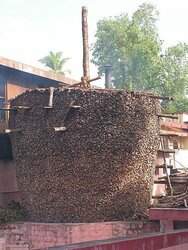I agree with Adios, and I'd add these two benefits:
- a square tarp covers it nicely (couldn't find a round tarp)

- it holds a lot of odd size wood pieces I generate that are otherwise really tough to stack
I'm no expert. I've built two of them. It's a labor of love and takes a bit more time, care and skill than a row. The chipmunks seem to love them and I've seen at least one raccoon and an opossum crawling in and out from beneath the tarp, although they seemed to just be exploring.
On my first holz I used junk branches in the middle to keep the wood off the ground with some splits as the perimeter foundation, using an old RR tie and some stakes on the downhill side. On my sloping hillside (probably 3 or 4% grade) this thing moved (above the base) a bit and I had to re-stack after a part of it collapsed after about 5 months. It was surprisingly quick to repair, though. The foundation is important. Level ground is best.
On my second holz
http://picasaweb.google.com/moheatmail/MoPhotos/photo#5141018242337323218
(see also: "My Wood" link in my sig)
I used some landscape blocks for half the perimeter (lowest side of hill) with spits for the rest to try and get a level foundation. It was more level than the first holz, but not perfect. I put branches inside again to keep the wood off the ground. This one moved less. It did bulge though, after about 5 months, so I unstacked the bulge and redid it before it probably would have "blown out". Didn't take very long to fix.
The next one I build will probably have the landscape blocks as about half the perimeter (lower half) with some gravel to eliminate the need for branches to keep the wood off the ground. That's my plan, anyway.
I love these things, but my neighbors are the kind that have threatened to call the police on me (and did once) just for making a little noise during tribal gatherings, so I figure they are less likely to complain if they think I commissioned some esoteric "wood art" than if I am simply a "termite magnet".
It's not your father's wood pile.




 enquiring minds and all that...
enquiring minds and all that...